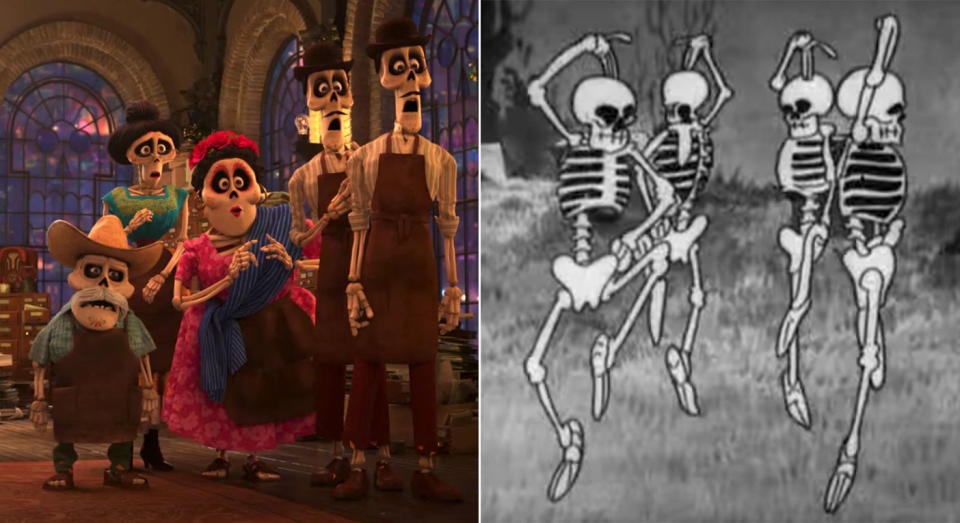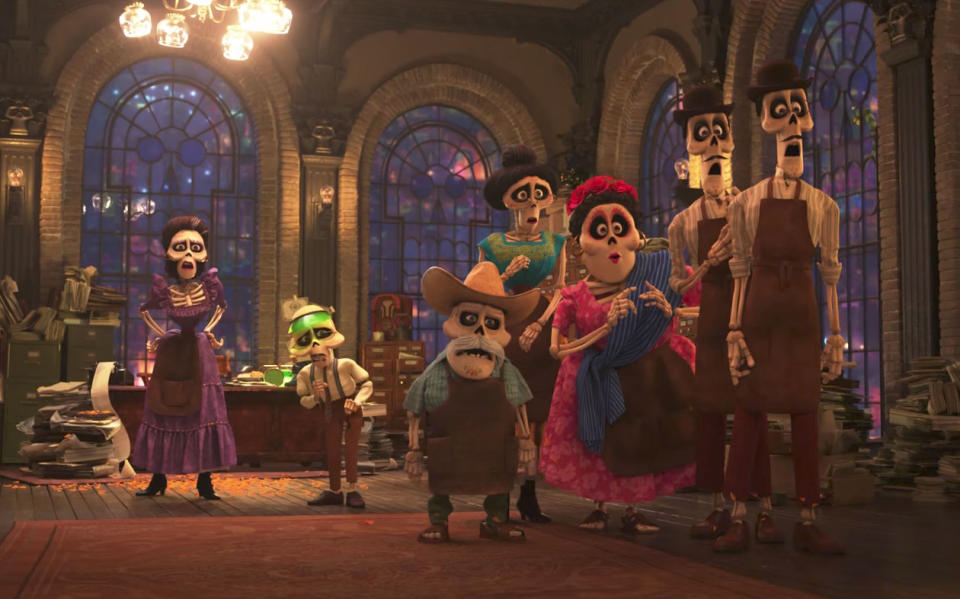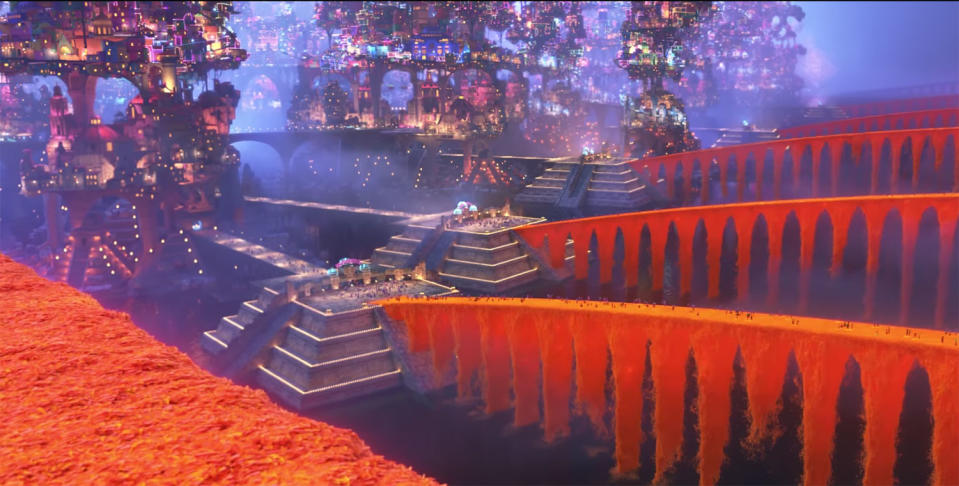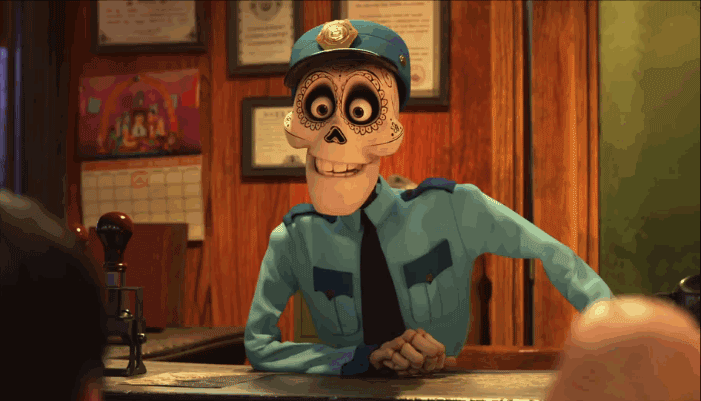Coco preview: The 1929 Disney cartoon that helped Pixar breathe life into its skeletons

Pixar’s upcoming music-tinged Mexican adventure ‘Coco’ is set to take the animation studio somewhere it’s never been before: into the world of the macabre.
Its parent company Disney has a rich history of dealing with the darker side of life. From its ‘Haunted Mansion’ theme park attractions to 1946’s animated ‘The Legend of Sleepy Hollow’, Walt Disney never shied away from spooks and scares, and it’s from this rich heritage that Pixar has repeatedly turned to for inspiration in ‘Coco’.
At a recent UK preview event, we learned that ‘Coco’ tells the story of Miguel, a young Mexican boy who travels into the Land of the Dead to track down his ancestors. He hopes that his deceased relatives will help him to understand why his living family have a strict music ban, when all he wants to do is become a Mariachi-style guitar player, just like his hero Ernesto de la Cruz.
Miguel soon learns that the residents of the stunningly realised Land of the Dead (the huge city is built in towers with each layer representing an era in history, from the Aztec pyramids at the bottom to the modern houses of the present day at the top) are all skeletons.
The skeletons move like regular people, but have been joyfully animated by Pixar to give their bones and bodies a loose, disconnected feel. One hilarious animation test showed Miguel and his dead companion Hector (voiced by Gael García Bernal) on a trampoline. Hector’s limbs gradually disconnect from his body with each bounce, leaving Miguel scrambling to put him back together.
The film’s co-director and writer Adrian Molina revealed to Yahoo Movies that a 1929 Disney cartoon played on hard rotation in the Story Room as a reminder to keep the potentially scary creations fun. “We always used to have ‘The Skeleton Dance’ playing in the background of our story room,” Molina told us, “Just to remember the history.”
“It was always a fun touchstone just to remind us of the ability to have fun with it, and to create characters which so much potential for appeal in animating skeletons.”

‘The Skeleton Dance’ is a short black and white ‘Silly Symphony’ animation, directed by Walt Disney himself (watch it here). The short film showing four skeletons dancing in a spooky graveyard is considered a seminal work of animation. In a 1994 book, it was named #18 of the 50 Greatest Cartoons of all time by animation professionals, and watching it now you can see why the Pixar bods found it so helpful.
Molina said the look of the skeletons was also inspired by famed Mexican artist José Guadalupe Posada. Posada’s depictions of decorated skulls (calaveras) is now synonymous with Día de los Muertos (Day of the Dead), the Mexican festival that is celebrated by ‘Coco’.
Here’s what else we learned from co-director Adrian Molina (‘Toy Story 3’s Lee Unkrich is the other co-director) and producer Darla K Anderson.
Adrian, what was your Pixar journey to co-directing ‘Coco’?
Adrian Molina: I started at Pixar as a story artist about 11 years ago and my first project as a story artist was ‘Toy Story 3’ with Darla [K Anderson, Producer] and Lee [Unkrich]. Very early on that project they just gave me a lot of freedom to explore scenes and adlib – if you will – in the storyboarding. And I enjoyed that freedom.
We just had a great relationship of creating an environment to make great scenes. So when I heard that Lee had pitched and got the greenlight for a film about Dia de los Muertos I was like ‘I have to work on that’. I come from Mexican heritage, I love working with Lee and Darla, and I started storyboarding on the film.

I may have been overly excited, but every aspect of it, I was super into it; it was all I would think about when I went home. There would come certain points on the film where story is tricky and solving problems, you can come at it from any number of directions, and you never know where the right idea would come from. But there were some problems that had been sticking points on our team for a while, and I said to Lee ‘I’ve got some weird ideas for how we might be able to navigate this, but I don’t have time to storyboard it right now. Can I write up pages, I just need to get it out of my system? You let me know if it’s helpful or not.’
So I wrote up some pages and Lee read them and it was just very fortunate that he was like ‘this has been a scene that has been sticky for me, but I’m interested in what you’re doing here. Do you have any other ideas?’ So I started writing more and more scenes. The more we sat in the story room and talked about how scenes could go, and what the movie could be, the more we just realised that we were on the same page about pretty much everything, so that very naturally turned into this situation where we both had the story in our brains, we were both agreeing on everything, and he asked if I would co-direct to be able to provide that voice and provide that perspective of the history of where the story had come from, and to get this movie finished.
Darla: He’s been a dream co-director on this film and so helpful in all of the reviews…
Adrian: I bet you say that to all the co-directors!
How do their personalities compliment each other as co-directors?
Darla: It’s interesting because they’re both very similar in makeup. At first I was unsure whether there might be conflict, but there just wasn’t. They really shared a brain about what this movie needed to be, and the story we needed to tell. They had the same sensibilities. This is a huge film, it has a lot of characters, a lot of details, so with Adrian as writer, coming up with story, it has been very – in cultural specificity – it’s been very helpful to have him in every review. Lee can turn to him and say, ‘remind me what we were thinking’ or ‘what was my point of view?’ and Adrian will speak up. There’s never a divergence of opinion. They both are together in this united vision for the movie, which is great.

Adrian: There are some times where there’s divergence. What I really love about working with Lee is that we both come from a place where the priority is always ‘what can we do to make this film stronger?’ So it becomes when you can try to take that fresh perspective all the time. It becomes easier to let go of past versions, and let go of egos, and let go of all this stuff that’s not helping this story. If we’re both in agreement on doing whatever it takes to make the story the best it can be, that sets the foundation for making it really to have hard conversations that makes the film stronger.
You say this is a huge film, but surely every Pixar film is huge? What makes this bigger than usual?
Darla: There are a lot of different sets, the sets are very ornate, but yes, it’s true all of our films are huge. This does have so many characters and the characters are very detail-oriented; they’re skeletons or they’re humans with layers of clothing on them, which provides visual rich complexity.
The land of the dead that we see in the trailer is stunning, that must be a huge design task in itself?

Adrian: I think there was one guy – Michael Frederickson – who was alone, his entire project on the film was just figuring out how do you build a city at that type of a scale and just creating tools to be able to be able to create that look. It was a project where Lee had this vision of this city built out of eras of history, and everyone was like ‘yes, that sounds beautiful, that sounds awesome. We can’t do it!’
No-one knew how to do it, at that level of detail. That’s where we’re so lucky to work at a studio with such creative minds, and such artistic and logistical geniuses where they start to chip away at the problems and all of the ‘no you can’t, no you can’ts’ and they start to find solutions for how we could.
You can see it on the screen it’s just absolutely stunning, and I don’t know how it happened, but I’m thankful it did.
What was the original idea that Lee pitched and how has it developed?
Adrian: The initial pitch always involved this idea of the journey through the Land of the Dead, but it went in a couple of directions where it could go one way, but we weren’t really grounded in the right specifics until we started to go on these research trips.
We just got to experience Dia de los Muertos in the places where it was celebrated, and understand the meaning behind each of the traditions from the ofrendas (shrines built by families to their ancestors) to the path of the [aztec] marigold petals to the decorating of the cemetery and staying out all night.

The more that we got to experience these elements the more that we began to see the type of story that could only be told in this type of setting, and it became a really great spring board for a story about this boy who lives in a family where he has a passion but it goes against their traditions.
It’s a boy who’s struggling against these traditions, but ultimately trying to find a balance between the person I want to be, and the person my family expects me to be. Once we locked in on that, just from a standpoint of it being true to the celebration, it became a lot easier to use that as a compass. Knowing which elements to pull in and how to use all of these traditions in order to dramatise that conflict, I think that was the most helpful thing. All of the research was just a wealth for storytelling ideas.
Did you draw on any historical Disney representations of skeletons for this?
Adrian: We always used to have the ‘Skeleton Dance’ playing in the background of our story room, just to remember the history. It’s from the 1930s or something.
Darla: We had that looping constantly.

Adrian: It was always a fun touchstone just to remind us of the ability to have fun with it, and to create characters which so much potential for appeal in animating skeletons.
Then we also drew a lot of reference from José Guadalupe Posada. He’s a Mexican artist and his stuff is the iconic Dia de los Muertos imagery that you’ll see associated with the holiday. So letting that inspire this look and feeling of a world of skeletons that still has a lot of levity and a lot of colour and vibrancy. It’s kind of ironic, but fantastic, that of all the places you go to in this film it’s the world of the dead that ends up being the most lively.

Music plays such a big part in Coco, was there ever a temptation to make it a straight musical?
Darla: We played around with everything, but we let the stories tell us what they need to be.
In this case the story kept us leaning to where we ended up being and it leant itself to being this particular story which is more performance based musical. This is a kid who wants to be a musician and so there’s going to be a lot of music in the film. It definitely enhances the story and is an indelible companion of this film.
Adrian: You never have a moment where, like in a traditional musical, they break out into a song about their feelings. But we use the performance of music to push the storytelling forward and to challenge our character more, and just to make it really fun. Because Mexico, anywhere you go, it’s humming with music and we just really wanted to give that feeling in the film where while it’s not a musical, it is a world that is built around music.
This is the second time Pixar has released two films in one year. What has the studio learned since 2015 when you released ‘Inside Out’ and ‘Good Dinosaur’?
In unison: That it’s really hard!
Adrian: But there’s so much energy and excitement at the studio in a year where we create two films. There’s this spirit of rallying together it’s like ‘we got that one done, now we’ve got the next one up to bat’. It’s got its own challenges but people are in sharp form because they’re just stretching their animation muscles.
Darla: I think we got a little bit better on this, on the marathon of it all. It is fun because we’ve all been working together for so many years, so we’ve been so excited about ‘Cars 3’ opening up this weekend, and rallying for our friends. We were just in Annecy [Annecy International Animated Film Festival and Market in France] for some of them, and I produced the first ‘Cars’ so there’s a connectivity with all of our films.
Adrian: We all just have to hold hands and say ‘OK here we go – next one!’
Darla: It’s such a kind culture, so everybody is so considerate about resources and helping each other out, so we’re very fortunate as a place to work in that way.
It’s a great celebration of Mexican culture, what are you hoping people take away from that?
Adrian: My hope is that when you’ve seen this film you walk away with two things. One of them is a desire to pick up a musical instrument and play it, just because it’s so built into the story and the character, that I think it’s infectious.

The other thing is, in the spirit of the Day of the Dead, that you leave the theatre wanting to call up your family and ask them about the stories of your grandparents or your great great grandparents. Ask your parents about their own stories. A lot of the times we never get the opportunity to make that connection, or we never think to ask. I think what this film really puts a spotlight on is that so much your family’s story is your story if you only think to ask.
Darla: In particular to Mexico, like we did with ‘Brave’ for Scotland, or ‘Ratatouille’ with Paris, you get to vicariously go to an adventure in another fantastical, beautiful, different other world. We hope people fall in love with it as much as we have.
Adrian: It’s a party!
Darla: It’s a gorgeous party.
‘Coco’ arrives in UK cinemas on 1 December.
Read more
The weirdest Cars fan theories
How all the Pixar films are connected
Incredibles 2 update

 Yahoo Movies
Yahoo Movies 
